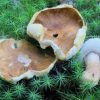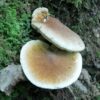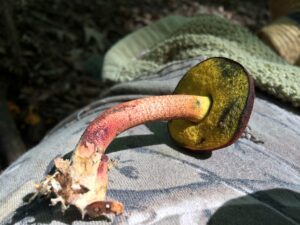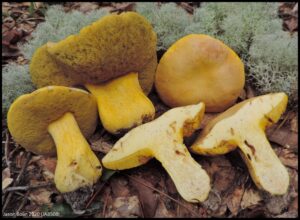Description
Genus: Gyroporus
Species: borealis (North) or smithii (South)
- Species (Old): castaneus
Common Name: “Chestnut Bolete”
Tells: Stem stuffed with “cotton” & hollow when old. Flesh is hard and brittle. Brown cap edges often split & flare w/age.
Other Information: DNA testing tells us the U.S. has two lookalike species, borealis in the north and smithii in the south. The two are indistinguishable for practical purposes, though some say the northern one can have bigger pores (when mature) and a slightly redder hue (a variable characteristic for all).
Science Notes: DNA evidence has divided the classic European species (G. castaneus) away from its American counterpart, which has itself been divided into versions: G. borealis (which grows in northern regions) and G. smithii (which grows to the south). There is, of course, a massive area of overlap where both species grow.
Edibility: Most say choice, others say only very good.
CHEMICAL TESTS:
- NH4OH (Ammonia): Cap skin turns amber-orange. Cap flesh may turn pale brown, but not reliably.
- KOH: Cap skin may be negative or may turn yellow before fading to white. Cap flesh may turn pale brown, but not reliably.
- FeSO4 (Iron Salts): Cap skin does not react. Cap flesh may turn pale brown, but not reliably.
Links:
- iNaturalist (G. borealis)
- iNaturalist (G. smithii)
- Mushroom Expert
- Mushroom Observer (G. borealis)
- Mushroom Observer (G. smithii)
- Wikipedia
- Google Image Search
 |
0 |  |
331 |  |
189 |  |
209 |










Got something to discuss?
I do believe this mushroom is found on Long Island, NY. I have eaten them from my lawn, and also seen them on the edges of Oak and Beech forests here on the South Fork. They are delicious.
I just checked and it is now listed in the Long Island Mycological Club records. The change has been made. Thanks for the heads-up.
Found in Louisiana as well